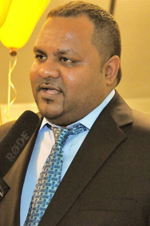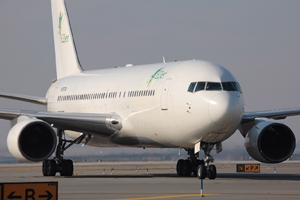Swirling questions over source of EZjet
- Owner reveals he holds full-time job in US, has US$348,000 mortgage on Florida home
- charter loses US$3M since December launch
With the government already denying that former President Bharrat Jagdeo and his best friend
Ranjisingh ‘Bobby’ Ramroop, have links to new charter EZjet, there are burning questions about the source of financing for the US-based charter company.
EZJet started flying the New York- Guyana route in mid-December.
Already, according to initial figures, the company has racked up more than US$3M ($600M) in losses and under current market conditions, is unlikely to ever make a profit.
This is raising even more questions about how the investor ever found the initiative feasible.
Recently, Head of the Presidential Secretariat Dr. Roger Luncheon denied that former President Jagdeo had any financial interests in EZjet. He said that the funding was being provided by “American Guyanese.”
But when Sonny Ramdeo, the man who said that he founded the charter, called Kaieteur News, he insisted that he was the sole person providing the finance at this stage.
He said that there are “sleeping” investors who have provided reserve funding.
Airline officials are wondering whether there is more than meets the eye on this charter, since despite plugging and spending millions on the initiative, the owner still holds a full-time job as a payroll director at a health care facility in the US.
Ramdeo disclosed, too, that he has a US$348,000 mortgage on his Fort Lauderdale, Florida home.
Investigations by Kaieteur News have revealed that the charter company which made its first flight to Guyana on December 15, even when fully booked, would barely recover half of the hefty US$150,000 it costs to operate a return trip between New York and Georgetown.
The US company applied under the Jagdeo administration and was granted the approval.
The owner and Chief Executive Officer (CEO) of EZjet, Sonny Ramdeo, during telephone interviews with this publication is insisting that he has no local investors from Guyana. He is the principal in the charter and it is his money, he claims.
Guyanese had suffered several bad experiences in the past after a number of charter companies left suddenly, he said. In instances, hundreds of passengers were left stranded and unable to recover their ticket money.
Ramdeo said that this and the treatment Guyanese got when coming through Trinidad forced him to start the charter. He said that on one occasion when he was coming to Guyana, and he says that he does so about 12 times a year, he was almost stripped naked.
Ramdeo, who said he made his money as an investment banker in the US, has himself made some startling revelations about EZjet’s finances.
Bad investment
EZjet is currently conducting five round trips weekly between the two destinations.
Officials in the airline industry said that they were surprised when EZjet was announced into the local market and introduced the current price structure. There was not much fanfare for the announcement.
“It is mind-boggling. Even if you own your own aircraft, it is difficult… even if you put passengers on the wings, it would be unprofitable,” a senior airline official said.
“This is one of the riskiest businesses on the face of the earth. With fuel price as it is on the high side, no one individual and a few persons would be willing to invest the kind of money that is needed for a charter like this.”
The company, according to Ramdeo is spending around US$73,000 on fuel and another US$74,000 to rent the Boeing 767-200 along with crew from Dynamic Aviation, a company based in Bridgewater, Virginia, US.
The fuel cost is computed on a flying time of 11.5 hours round trip. Ramdeo says that he buys fuel at US$3.50 per gallon in the United States. In Guyana he would pay no less that US$5 per gallon
However, the current “low” price of US$529 on average for a return ticket makes it unfeasible since US terminal fees alone is US$52 per passenger. The ticket also includes handling and a 10% agency fees and 15% overhead costs, which all have to be discounted leaving EZjet with around US$350 for each ticket sold.
Assuming that all 218 seats of the plane are sold, EZjet would be raking in around US$80,000 – this is US$70,000 short of the US$150,000 it normally costs to operate each return flight New York and Georgetown.
Ramdeo said that his wet lease—aircraft and crew—costs US$74,000 per round trip. He added that his catering bill is US$1,600; that he buys fuel in the United States at US$3:10 per gallon and that he buys 1,500 gallons.
He says that these things allow him to operate a cheap airline when compared with Delta and Caribbean Airlines.
Another shocking revelation is that since the flights started in December, EZjet has been doing poorly, with its January 2012 manifests indicating an average of around 92 passengers per flight…or about 42% full. On two occasions in December, days before Christmas, it even flew almost empty with six and seven passengers on consecutive flights.
And the baffling questions are many. Why would Ramdeo plug millions into a losing project that hinges on fuel prices which analysts say are likely to rise even further in coming months?
Emotional investment
The CEO has his own explanations why EZjet entered the Guyana market.
“I come to Guyana (often). I am Guyanese. I see people frustrated with travelling…they don’t have a choice.”
However, airline officials said that emotions hardly have any place in the industry.
Ramdeo insists that he is shopping smart for fuel and even making savings on catered food, something that has left airlines like Delta and Caribbean Airlines with huge tabs, which ultimately affect the ticket prices.
“We don’t look at passengers as dollars. We look at them as repeat customers. Some of them have even traveled five-six times with us.”
Ramdeo, a former villager of Windsor Forest, West Coast Demerara, also stressed that EZjet is not burdened with huge overheads like union fees- factors that Delta and Caribbean Airlines have to deal with.
“The Catch-22 is that our product is better than the two.”
Asked whether the company has been profitable, Ramdeo said that “actually our name has been building…we anticipated some losses…we have not had any substantial loss to capital.”
He insisted that his passenger load was up to 85% per trip during the recent Carnival in Trinidad and Tobago when there were “two weeks of full flights”.
For EZjet to get permission to fly the New York/Georgetown route, it had to deposit up to US$200,000 with the US Department of Transportation. There are no stringent background checks as in the case of a full-fledged airline. There are little checks to determine the viability, experience of the players or even whether the money comes from illegal sources.
In Guyana, a similar sum of US$200,000, that would reimburse passengers in case of problems, had to be lodged with the Guyana Civil Aviation Authority. Like the US, Guyana is not too insistent on conducting too much of an in-depth check into the source of financing and other due diligence checks on the charter companies.
Expansion
Ramdeo, despite the losses, is now looking to make EZjet bigger by reducing the five weekly flights to four and adding the Toronto/Georgetown route. Destinations like Trinidad and Barbados and a smaller plane are also on the horizon.
And comments from Ramdeo in justifying the investments are even more puzzling.
“Upfront, I am a businessman like everybody else. One of the things that irk me now even from the days of (President) Jagdeo is that they allow Caribbean Airlines to do what they want.”
To make things harder for EZjet to survive, Ramdeo admitted that his company is not getting a fuel subsidy like Caribbean Airlines which buys fuel for just over US$1 for a gallon. The charter company pays at least US$5 per gallon in Guyana and as he claims, US$3.10 in the US.
“And they (Caribbean Airlines) are operating at a loss. That is what you call mismanagement.”



